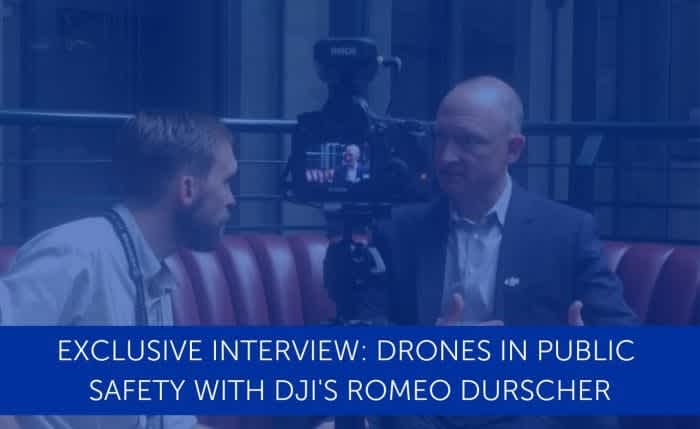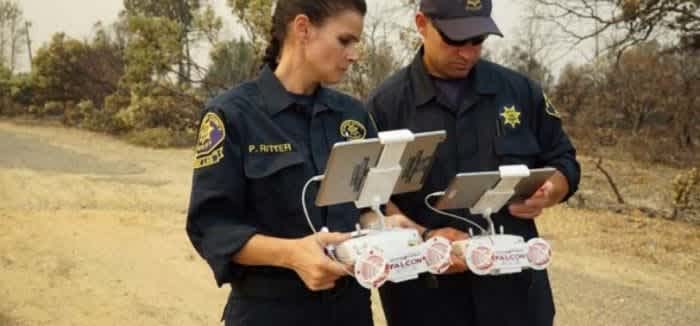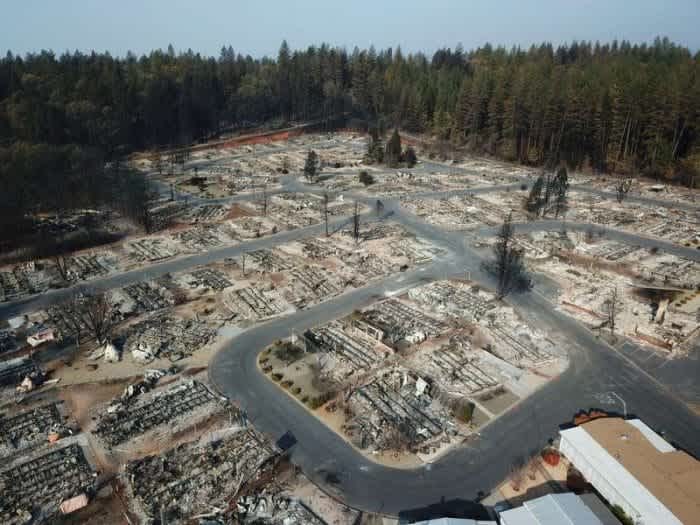
News
EXCLUSIVE INTERVIEW: Drones In Public Safety With DJI's Romeo Durscher
At AirWorks 2019, DJI's Romeo Durscher met Heliguy to talk about the current and future role of drones in public safety, tips to starting a commercial drone programme and how adoption rates are 'skyrocketing'. ... Read More

Drones are saving lives, transforming the work of fire and police crews, and adoption rates are 'skyrocketing' - these were some of the key industry insights from Romeo Durscher, DJI's Director of Public Safety Integration, during an exclusive interview with Heliguy at AirWorks 2019.
Speaking to Heliguy's content writer James Willoughby, Mr Durscher also set out his vision for the future of drones in public safety, addressed the challenges which face the industry, shared his tips for starting an enterprise drone programme and described Heliguy's launch into America as 'very, very exciting'.
This far-reaching one-off interview with one of DJI's most senior figures painted a fascinating picture about the current UAS scene and highlighted the potential of this incredibly powerful technology.
Below is the transcript, in full, of the AirWorks interview, with the speakers’ names indicated by their initials.
In-Full: Heliguy's Exclusive AirWorks Interview With DJI's Romeo Durscher

Heliguy's James Willoughby, left, with DJI's Romeo Durscher.
Introduction
JW: It is a pleasure to be joined by Romeo Durscher, DJI's Director of Public Safety Integration. Romeo, can you tell me more about your role please?
RD: I oversee the integration of our technology into public safety, and that can be law enforcement, fire, search and rescue, and we are also now seeing the emergency medical side utilising this technology in different and new ways.

Drones have become a key tool for public safety missions.
JW: What are these different and new ways?
RD: Imagine there is a mass casualty event and we need data and information.
We are utilising drones with the ability of the speaker to start communicating with potential victims.

The DJI Mavic 2 Enterprise can be integrated with a loudspeaker.
So we can do triage from far away and that data can help not only personnel to prepare for deployment, but also hospitals to prepare for incoming patients.
The whole concept of mass casualty event triage is something that is brand new.
From Consumer To Commerical - The Evolution Of Drones
JW: Over the years, drones have gone from hobbyist toys to key enterprise tools. How has that impacted the public safety sector?
RD: It has been a fantastic experience. About four years ago I really started to focus on public safety and we utilised various tools to better understand what are the needs of public safety.

Drones in the DJI M200 Series are a popular choice in the public safety sector.
One of those tools was a partnership with ENNA (European Emergency Number Association) in Europe. Through ENNA, we worked with four different pilot test sites - in Copenhagen, Iceland, Wales and Ireland - to get a much better understanding of the needs and capabilities of the new technology meeting those needs.

Romeo Durscher is a key player in the ENNA initiative.
And that really set the foundation for additional work that was done over the last four years.
Today we are seeing almost daily articles about drones being used to help save lives, to mitigate risks to our public safety officials on the ground, to doing damage assessments, pre-incident work to help eliminate the potential for a fire, and accident reconstruction. The list goes on.

Drones provide vital situational awareness to help decision-making.
Drones Provide Valuable Insights And Save Lives
JW: Which cases studies stand out that demonstrate the power of drones?
RD: At the end of the day it comes down to the data. The data that is being provided. Actionable data. If the incident commander can get more and better actionable data faster, then the incident commander can make better decisions.
We did a fascinating use case study last year in Ireland and in Wales through the ENNA project to better understand the impact of drones in search and rescue.

The ENNA project is helping to better understand the impact of drones in search and rescue.
We did 50 case studies with two legs. The first leg was the traditional search and rescue. The second leg was drone-enabled search and rescue and we wanted to measure how long it would take to find the victim and we wanted to compare them with each other.
In those 50 case studies, we were able to figure out that the drone saves at least three minutes if you are utilising a drone with a visible light camera and are flying manually.

A lot of work has been done to compare the differences between traditional search and rescue and drone-led search and rescue.
Now we have a baseline and we already know the drone is three minutes faster on average with those technologies - now what about if we add thermal cameras, what if we add autonomous flight functionalities and what if we use multiple drones working together - we can cut down that time it takes to locate somebody so much more.

Drones and thermal imaging are a vital tool for search and rescue. In this example, the thermal camera helped find a missing pensioner after ground searches had failed to locate her.
JW: Drones have helped save the lives of 279 people. That's an amazing statistic isn't it?
RD: It really is, and that statistic reflects the documented lives saved, where we have proof that the drone helped make that save.
The number is very likely to be much, much higher because we don't have all of the cases.

Drones are helping to save lives.
But regardless we have almost 300 people that are still with us today. That economic impact is tremendous and the emotional impact of their families and friends because they are still here with us and they don't have to mourn the loss is also tremendous. Just that number alone shows the potential of this technology.
Adoption Rates Are 'Really Skyrocketing'
JW: You mention the potential of the technology. How are adoption rates in the public safety sector?
RD: They are really skyrocketing. In the United States, we have roughly 40,000 police and fire departments. About 500 of those have a manned aircraft unit, so they have access to a helicopter or a fixed-wing.
All the others either have no access or share resources, so there's a huge potential for drones to come and assist because they may not have access to manned aircraft or to work together with manned aircraft as we are already seeing happening.
And over the last four years, we have seen an over 500% adoption rate in public safety and we are still very early on.

Drones are being used more and more in the public safety sector.
Almost weekly we learn about a new use case for the drone and as a community, as an industry, we are still learning how to best utilise it, what else can we do with the drone - all the different tasks which can eliminate the risks to either fire or police, but also help us with data that can make better decisions.
JW: Is there a difference between adoption rates in the UK/Europe and the USA?
RD: There are potential differences for a variety of different reasons. But what we see in the United Kingdom is a really amazing use-case portfolio within law enforcement.

The UK has an 'amazing use-case portfolio within law enforcement', says Romeo Durscher.
There are amazing use cases and tasks that have come out of law enforcement - from search and rescue to apprehending criminals. Those are the ones that we want to highlight because it shows the potential of the technology. It shows how new technology can be integrated to help protect and serve and that's what we want to showcase.
'We Will See More Sensor Integration'
JW: What is the future of drones in public safety?
RD: Well, it's data. We want to get the data to the right people as quickly as possible.
Sometimes we have an incident commander right at the scene. If they can see the drone footage live on a big screen, like what happened at the Notre Dame fire in April this year, it's tremendously beneficial to the incident commander and staff.

The view of the Notre Dame fire as provided by a drone.
But also we might want to get that data to an incident commander that is further away - maybe at the fire station or at another entity - so getting the data to those places fast with very little delay and adding additional information to it, to me that is the future.
And on the hardware side, we will be seeing more sensor integration.

The M200 Series can be integrated with a range of payloads.
We already have visible light and thermal light cameras that provide us with an amazing overview, but now we are also starting to see multi-gas sensors that are included and attached to the drone so we don't have to send people to dangerous areas.
We can send a drone that provides us with information about what type of gas we are dealing with, what type of quantities, is the cloud moving and that information helps save lives and lets us make better and faster decisions.
Drones For Good - Public Safety Can Help Spread The Message
JW: During a seminar at AirWorks there was a discussion about how public perception can make or break a drone programme and it was mentioned that public safety officials need to take the lead on boosting the public perception. Would you agree with that?
RD: Absolutely. We have an amazing opportunity right now to, in essence, bring public safety to a next level.

Romeo Durscher believes that the public safety sector can help take the drone industry to the next level.
I always like the reference of one fire chief who said that the drone is the best invention after the fire hose.
If we as a community can help to bring public safety to the next level then the public benefits from it because if we can help save that child that is missing or if we can help to protect a building from going up in flames or get better decision-making capabilities to incident commanders to protect his or her own people, that has a tremendous benefit for everyone.

London Fire Brigade used this thermal image - from a DJI Zenmuse XT2 camera integrated with a DJI M200 Series drone - to help tackle a warehouse fire.
So yes, public safety has an amazing opportunity to not only utilise drone technology, but use it in ways that help the entire public.
What Challenges Lie Ahead?
JW: There's no doubt that drones have transformed public safety. But what challenges does the industry face?
RD: There are a lot of challenges and we have overcome many of them already.
But this is new technology and every time we have new technology come to market it always takes some time to really figure out how does this all fit in.

Drones are helping rescue teams.
And in public safety we are very standardised and task-specific and now here is this disruptive new technology that we are trying to integrate and sometimes there is push back because we don't always have the right answers, so we are still learning, we are adapting.
As an industry we are listening to public safety officials. We want to know what do they need, so we can build not only the hardware, but also the software to meet those requirements.

DJI says that it listens to public safety officials to make the best possible drone solutions.
We want to make their jobs easier and safer so together we are learning, we are adapting our platforms and software, we are building relationships with ecosystem partners that can provide solutions and all of this is just falling into place as we speak and to me, it is very, very exciting.
Just last year we had a large-scale deployment in California during the wildfires and I was part of a team that responded with 16 public safety drone teams from both law enforcement and fire and together we operated over 600 missions.

A drone image of the wildfires in California.
We flew fire scenes, we did mapping projects, we did body-recovery projects - it was tremendous to see large-scale deployment already happening, fully-integrated into the airspace with manned aircraft still flying over us, dropping water at the frontlines.

Drone mapping was a vital part of the response following the wildfires.
We can do all of this today. Imagine what we can do in a couple of years.
Tips For Starting An Enterprise Drone Programme
JW: What advice what you give to a public safety organisation considering starting a drone programme?
RD: There's one thing that is crucial - start small.

'Start small'. Romeo Durscher's advice on starting a drone programme.
Find one use case that you want to focus on. That could be accident reconstruction, for example.
If your department is able to reopen a road 25-to-40% faster than with traditional methods, that's a big win. That means the public can use that road quicker, it has an economic impact, and it gets you home sooner. Those are big wins.

'Don't reinvent the wheel', says Romeo Durscher.
So start with one use-case, get good at it, network with other departments that have an already established drone programme. Don't reinvent the wheel. Somebody has already done a lot of groundwork.
We (DJI) are happy to make introductions and network - that is part of AirWorks. That is why so many entities have come to AirWorks to meet others and learn from others so that they don't have to reinvent the wheel.
What Have You Learnt At AirWorks 2019?
JW: What have been your main takeaways from AirWorks 2019?
RD: We are so much mature from last year or the year before and that shows that this (drones) is a serious solution, it has already become something that is fully integrated into departments and that is exciting to see.

AirWorks 2019, held in Los Angeles, brought together some of the biggest names in the drone industry to share knowledge and innovation.
We have departments from all over the world here today. That's an amazing attest to the belief in this technology and its capabilities.
We have the second-largest department in the world (Fire Department City of New York) here with us talking about the drone technology, we have Los Angeles Fire Department, which is the third-largest department in the United States, also talking about it.

Heliguy's Ruairi Hardman, centre, met representatives from the Fire Department City of New York at AirWorks 2019.
Obviously no matter how big or small your department is, the drone potentially has a home or a place, but just start small and then scale up.
Heliguy Is 'Now Part Of Our American Family'
JW: Heliguy is a DJI Gold Partner and has won a DJI award for enterprise. What are your thoughts on Heliguy launching in America?
RD: This is exciting. Heliguy is crossing boundaries, just like a drone does, and that is what it is all about.
We are all one ecosystem across the globe. Yes, there are differences in how we operate between areas but we can all learn from each other.

Heliguy announced our American launch at AirWorks 2019.
Heliguy can now bring your experiences to America and you can learn from our experiences and bring that back.
There are a number of great benefits and I am excited to say that Heliguy is now part of our family in the USA.
Rallying Call To Drone Users - 'Please Obey The Law'
JW: Is there anything else you would like to add?
RD: If you're a hobbyist or a commercial operator, please obey the law and regulations wherever you're flying.

Romeo Durscher has urged drone pilots to obey the law.
Don't interfere with public safety operations and don't interfere with large-scale operations - you could hinder the efforts of fire or law enforcement.
But enjoy, be creative out there and utilise this technology to help your business, to help your creative mind and have fun.
Heliguy would like to express its thanks to Romeo Durscher for taking the time to speak to us exclusively at AirWorks. It was fascinating to speak to him and we are delighted to be able to share his industry insights. To find out how Heliguy can support, scale or start your enterprise drone programme - including in public safety - visit our website. Heliguy currently looks after more than 40 of the UK's emergency services.
